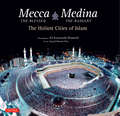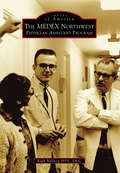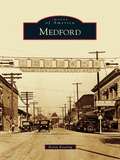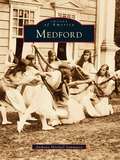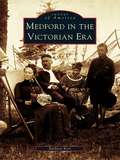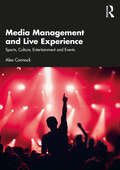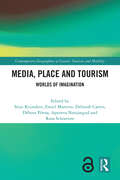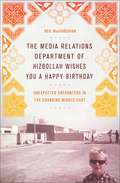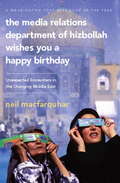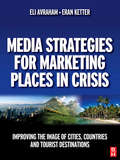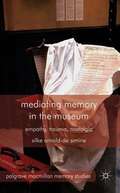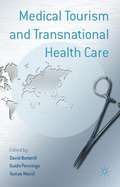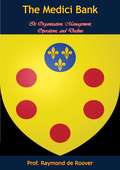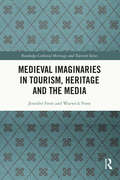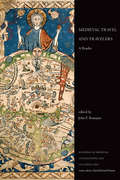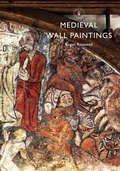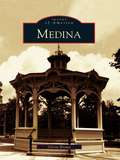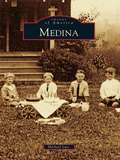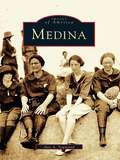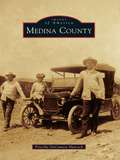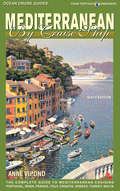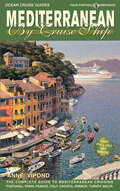- Table View
- List View
Mecca the Blessed, Medina the Radiant
by Ali Kazuyoshi Nomachi Seyyed Hossein NasrDuring the season of Ramadan, when the first revelation of the Qur'an is commemorated, more than a million visitors journey to Mecca's Great Mosque. Despite Islam's position as a powerful religion, boasting one quarter of the world's population as its followers, many aspects of Muslim thought and belief remain an enigma to non-Muslims--until now.While the cities of Mecca and Medina are restricted to Muslims, and photographing the sites requires special--and rarely given--permission from the Saudi Arabian authorities, Mecca the Blessed, Medina the Radiant is an unprecedented exploration of Islam's most holy cities and the great pilgrimage, mostly presented in full-color, never-before-seen photographs. A remarkable achievement, Japanese photographer Ali Kazuyoshi Namachi garnered the full support of the Saudi Arabian authorities to capture over 140 stunning and dynamic images, providing an opening to the mystical places and scenes of Islam. From breathtaking aerial photographs of the Arabian terrain, to vistas of teeming crowds of worshippers surrounding the Kacbah, Mecca's sacred center and the fulcrum toward which they face in prayer five times daily, to intense portraits of faithful Muslims in prayer, to the magnificent architecture reflecting the faith of the believers, this book allows both Muslims and those unfamiliar with the Islamic faith complete access to the holiest sites of one of the world's major religions. A selection of archival illustrations are also included to supplement the photographs.Also featured is an essay about the spiritual and historical signficance of both Mecca and Medina as well as a discussion of the meaning and symbolic content of the hajj--the Muslim annual pilgrimage to Mecca--by Seyyed Hossein Nasr, one of the most highly regarded scholars of Islam.
MEDEX Northwest Physician Assistant Program, The (Images of America)
by Ruth Ballweg MPA PA-CThe MEDEX Northwest Physician Assistant Program was created at the University of Washington in 1968 as one of the nation's first physician assistant (PA) programs. A joint project of the Washington State Medical Association and the University of Washington School of Medicine, MEDEX was designed to meet the needs of overworked physicians in rural communities. As envisioned by MEDEX founder Dr. Richard A. Smith, "Physician Assistants were created by physicians, for physicians." Initially, all MEDEX students were former military corpsmen returning from Vietnam. Based on their extensive clinical experience, they were well accepted by doctors and their patients. Dr. Richard Smith was a former Peace Corps physician and leader of the federal project to desegregate the US hospital "system" as a requirement for Medicare reimbursement. Dr. Smith's founding principles for MEDEX included a collaborative model for community and practitioner involvement--the framework for the MEDEX Program throughout its 45-year history.
Medford
by Kevin KeatingIradell Phipps and Conrad Broback saw a golden opportunity in 1884. After convincing the railroad to build its depot on their prairie land near Bear Creek, they began building what became the second-fastest growing city in America, with over 100 new buildings in its first year. Few Medfordites today know that the city once had four separate railroads and was renowned throughout Europe. Intrepid flyers Eugene Ely, Pat Patterson, Seely Hall, and Charles Lindbergh made Medford a regional air hub during the early days of flight. In 1910, Medford had more automobiles per capita than any town in the world, and in 1923, it straddled the world's longest paved road. Told through photographs, facts, and anecdotes, the story of the hometown of film and radio stars Pinto Colvig and Ginger Rogers, as well as sports greats like Dick Fosbury, Bill Bowerman, and Kyle Singler, is a captivating read.
Medford (Images of America)
by Anthony Mitchell SammarcoReferred to in its beginning as a "peculiar town," Medford was originally a town but a plantation owned by Governor Matthew Craddock. Known as Meadford at the time of its settlement in 1630, the area was a flourishing village located along the Mystic River that boasted numerous farms, fisheries, and shipbuilding. A small town for the first two centuries after it was settled, Medford was conveniently located only a few miles from Boston. Its prime location soon attracted thousands of residents, and by the turn of the twentieth century, Medford had become a cultural mecca with over 18,000 residents. The town's strong sense of community and respect for diversity has continued through the years, transforming a small fishing and farming village into one of the finest residential communities in metropolitan Boston. In Medford, author Anthony Mitchell Sammarco invites his readers to join him on a journey back in time to an earlier Medford, when local transportation meant a ride on a horse-drawn streetcar or a train ride on the Boston & Lowell line. Within these pages, learn little-known facts about the founding of renowned institutions such as Tufts University, view candid snapshots of early Medford residents at work and at play, and discover rare photographs of the area's more unusual influences, from the exotic foods and customs introduced by European settlers to the impact of the town's gypsy moth dilemma.
Medford (Then and Now)
by Patricia SaundersMedford, originally referred to as Meadford, was settled as a plantation in 1630 by Gov. Matthew Craddock. A historic city located on the Mystic River in Middlesex County, Medford gained fame from its clipper ships, crackers, and rum. The song "Jingle Bells" was composed here by James Pierpoint in the early 1850s. Many prominent citizens have lived in Medford, including Amelia Earhart, who moved to the city in 1924. Medford, part of the Then & Now series, connects this city's past with its present by comparing historic and modern photographs of sites such as the Royall House, Jonathan Wade House, and Peter Tufts-Craddock House.
Medford in the Victorian Era (Images of America)
by Barbara KerrWhen the Boston and Lowell Railroad came through in 1835, Medford was a quiet town with fewer than two thousand residents. By the twentieth century, it had become a thriving city of eighteen thousand. In Victorian Medford, everything was new, from the Medford Opera House, the town hall, and the Mystic Lakes to the camera, the bicycle, and the gypsy moth. The shipbuilding, rum, and brickmaking industries gave way to new businesses, and traditional houses came to share neighborhoods with Queen Anne and Shingle-style architecture. In the mid-nineteenth century, there was great social change, as abolitionists Lydia Maria Child and George Luther Stearns spoke out against slavery and men went to the Civil War. James W. Tufts invented the soda fountain, Fannie Farmer wrote her first cookbook, and James Pierpont wrote "Jingle Bells."
Media Management and Live Experience: Sports, Culture, Entertainment and Events
by Alex ConnockGlobal and authoritative, this textbook maps modern, live experience media, the categories that thrive on real-time engagement and human connection – even in the age of synthetic content, AI and the Metaverse. Sports and sports betting, festivals, comedy, concerts, tours and theme parks are covered – plus theatre, trade events, conventions, museums and galleries, and immersive media.Live media events included are Burning Man, Glastonbury, the Indian Premier League, the English Premier League, Olympics, NBA and Bundesliga – plus sell-out Taylor Swift tours, the World Cup, Super Bowl, Ryder Cup and Formula One. Business models in this media category start with ticketing and advertising – now amplified with ecommerce, affiliate marketing, subscription and gambling transactions. Deep dives ask: Why is Saudi Arabia investing billions into golf and football? Why is standup comedy big in Nigeria? How are Broadway and the West End evolving? What do immersive technologies like Abba Voyage and the MSG Sphere offer for the future?With class questions, a quiz, summaries and slides for each chapter, this is a guide and course structure for anyone at university level or in industry studying the media, music, entertainment, events, exhibitions, sports, social media or gambling industries.
Media, Place and Tourism: Worlds of Imagination (ISSN)
by Reijnders, Edited by Stijn Emiel Martens Deborah Castro Débora PóvoaAccessible and interdisciplinary in nature, this volume highlights the connections between media, tourism and place, bringing together the diverse perspectives, approaches and actors involved in critical issues relating to media tourism worldwide.This book explores new avenues, adopting a global and transnational perspective and placing emphasis on the exploration, analysis and comparison of cases from around the world. Encompassing chapters from a plethora of experts, the volume discusses processes and relationships of power involved in the development and experience of media tourism. This book seeks to broaden the horizons of both the reader and existing academic research into media tourism by including research into, among other topics, Bollywood and Nollywood films, Brazilian telenovelas and South Korean K-pop culture. Illustrated with tables and figures throughout, the volume presents insights from a variety of strands of cutting-edge and empirically rich research, which are collated, compared and contrasted to demonstrate the connections between media, tourism and place around the world.International in scope, this book is an ideal companion for academics and scholars within a wide array of disciplines, such as media studies, tourism studies, fan studies, cultural geography and sociology, as well as those with an interest in media tourism more specifically.The Open Access version of this book, available at www.taylorfrancis.com, has been made available under a Creative Commons Attribution-Non Commercial-No Derivatives (CC- BY- NC- ND) 4.0 license.
The Media Relations Department of Hizbollah Wishes You a Happy Birthday: Unexpected Encounters in the Changing Middle East
by Neil MacfarquharWith his counterintuitive sense since his boyhood in Qadhafi's Libya that the Middle East, despite all the bloodshed in its recent history, is a place of warmth, humanity, and generous eccentricity, Neil MacFarquhar introduces a cross-section of unsung, dynamic men and women pioneering political and social change. The author interacts with Arabs and Iranians in their every day lives, removed from the violence we see constantly, yet wrestling with the region's future.
The Media Relations Department of Hizbollah Wishes You a Happy Birthday: Unexpected Encounters in the Changing Middle East
by Neil MacfarquharSince his boyhood in Qadhafi’s Libya, Neil MacFarquhar has developed a counterintuitive sense that the Middle East, despite all the bloodshed in its recent history, is a place of warmth, humanity, and generous eccentricity. In this book, he introduces a cross-section of unsung, dynamic men and women pioneering political and social change. There is the Kuwaiti sex therapist in a leather suit with matching red headscarf, and the Syrian engineer advocating a less political interpretation of the Koran. MacFarquhar interacts with Arabs and Iranians in their every day lives, removed from the violence we see constantly, yet wrestling with the region’s future. These are people who realize their region is out of step with the world and are determined to do something about it-on their own terms.
Media Strategies for Marketing Places in Crisis
by Eli Avraham Eran KetterGrowing competition between countries and cities over attracting infrastructure, investment, tourists, capital and national and international status mean that today, a negative image is more harmful than ever. Whatever the cause of the negative image, places perceived as dangerous, frightening, or boring are at a distinct disadvantage. Many decision makers and marketers stand by helplessly, frustrated by their knowledge that in most cases, their city's negative image is not based on well-grounded facts. Given that stereotypes are not easily changed or dismissed, the challenge facing these decision makers is great. Analyses of many case studies show interesting examples of places that tried to change a negative image into a positive one, in order to bringing back tourists, investors and residents. Although a great deal of knowledge about crisis communications has accumulated in recent years, very little has been written about strategies to improve places' negative images. The aim of "Media Strategies for Marketing Places in Crisis" is to discuss the various dimensions of an image crisis and different strategies to overcome it, both in practice and theory. "Media Strategies for Marketing Places in Crisis" is based on the careful analysis of dozens of case studies, advertisements, public relations campaigns, press releases, academic articles, news articles, and the websites of cities, countries and tourist destinations.
Mediating Memory in the Museum
by Silke Arnold-de SimineMediating Memory in the Museum is a contribution to an emerging field of research that is situated at the interface between memory studies and museum studies. It highlights the role of museums in the proliferation of the so-called memory boom as well as the influence of memory discourses on international trends in museum cultures.
Mediation at the Holocaust Memorial in Berlin
by Irit DekelAnalyzing action at the Holocaust memorial in Berlin, this first ethnography of the site offers a fresh approach to studying the memorial and memory work as potential civic engagement of visitors with themselves and others rather than with history itself.
Medical Tourism: The Ethics, Regulation, and Marketing of Health Mobility (Contemporary Geographies of Leisure, Tourism and Mobility)
by C. Michael HallMedical and health tourism is a significant area of growth in the export of medical, health and tourism services. Although spas and improved well-being have long been part of the tourist experience, health tourism now includes travel for medical purposes ranging from cosmetic and dental surgery through to transplants and infertility treatment. Many countries including China, Cuba, Hungary, India, Thailand, Malaysia and Singapore actively promote and compete for the medical tourist dollar, while many developed countries also provide niche private services. However, the field of medical tourism is increasingly being subject to scrutiny and debate, particularly as a result of concerns over regulatory, ethical and wider health issues. Drawing on a range of theoretical and methodological perspectives, this book is one of the first to critically address the substantial political, philosophical and ethical issues that arise out of the transnational practices of medical tourism. Through a series of chapters the book engages with key issues such as the role of regulatory and policy structures in influencing medical and health tourism related mobilities. These issues are investigated by considering range of developing and developed countries, medical systems and health economic perspectives. The book adopts a multi-layered perspective to not only investigate the business and marketing practices of medical and health tourism but places these within a broader framework of contemporary globalisation, policy and practice. By doing so it opens up debate of the ethical space in which medical and health tourism operates as well as reinforce the wide ranging perspectives that exist on the subject in both the public and academic imagination. This significant contribution will be of interest to students, academics in tourism and medical policy, trade and economic development fields.
Medical Tourism and Transnational Health Care
by David Botterill Guido Pennings Tomas MainilMedicine and tourism have become separated in contemporary popular consciousness. The former implies anything but a pleasurable experience and the latter presumes a healthy disposition for participation. We argue that this popular conception of the separation of tourism and medicine ignores an historical continuity of lineage from the 18th century pursuit of a 'cure' at resorts and spas, to 20th century notions of holidays as worker welfare through to global patient mobility in the quest for cutting-edge medical interventions in so-called 'untreatable' conditions. Disciplinary divisions within the academy have reinforced the separation between medicine and tourism in popular culture, but there is now an emergent challenge to re-think the medicine/tourism nexus. Under the influence of transnational health care consumption, two very contrasting traditions of Western thought are now confronting one another. This book provides a comprehensive landscape of diverse research communities' attempts to capture its implications for existing bodies of knowledge in selected aspects of medicine, medical ethics, health policy and management, and tourism studies.
The Medici Bank: Its Organization, Management, Operations, and Decline
by Prof. Raymond de RooverProfessor Raymond de Roover received his MBA from Harvard University in June 1938, and it was during that summer that he, together with his wife, Florence Edler, an American scholar studying European economic history, photographed the records that would form the basis for this Medici Bank study.First published in 1948, this publication examines the structural organization and eventual fall of the Medici Bank, the largest and most respected bank in Europe during its prime in the 15th century (1397-1494). The book includes in-depth chapters covering the Florentine banking system; the structure of the Medici firm; the central administration and the branches; the management of the branches; the management of the industrial establishments in Florence; banking and exchange transactions; commercial transactions; the alum cartel; the sources of invested funds; and, finally, the causes of the decline.An important addition to the historical analysis of banking during the formative period of modern institutions.
Medieval Imaginaries in Tourism, Heritage and the Media (Routledge Cultural Heritage and Tourism Series)
by Jennifer Frost Warwick FrostThis book examines the pervading influence of medieval culture, through an exploration of the intersections between tourism, heritage, and imaginaries of the medieval in the media. Drawing on examples from tourist destinations, heritage sites, fictional literature, television and cinema, the book illustrates how the medieval period has consistently captured the imagination of audiences and has been reinvented for contemporary tastes. Chapters present a range of international examples, from nineteenth century Victorian notions of chivalry, knights in shining armour exemplified by King Arthur, and damsels in distress, to the imagining of the Japanese samurai as medieval knights. Other topics explored include the changing representations of medieval women, the Crusades and the Vikings, and the challenges faced by medieval cathedrals to survive economically and socially. This book offers multidisciplinary perspectives and will appeal to scholars and students across a variety of disciplines such as cultural studies, history, tourism, heritage studies, historical geography and sociology.
Medieval Travel and Travelers: A Reader (Readings in Medieval Civilizations and Cultures)
It is widely believed that people living in the Middle Ages seldom traveled. But, as Medieval Travel and Travelers reveals, many medieval people – and not only Marco Polo – were on the move for a variety of different reasons. Assuming no previous knowledge of medieval civilizations, this volume allows readers to experience the excitement of men and women who ventured into new lands. By addressing cross-cultural interaction, religion, and travel literature, the collection sheds light on how travel shaped the way we perceive the world, while also connecting history to the contemporary era of globalization. Including a mix of complete sources, excerpts, and images, Medieval Travel and Travelers provides readers with opportunities for further reflection on what medieval people expected to find in foreign locales, while sparking curiosity about undiscovered spaces and cultures.
Medieval Wall Paintings
by Roger RosewellWhat medieval wall paintings remain in English churches tend to be shadows of their former selves - rare fragments of art that have survived not only the Reformation, but successive waves of iconoclastic zeal and unsympathetic restoration. The whitewashed walls of most parish churches belie the riot of color and decoration that once adorned them, but the remnants of paintings tucked into corners or rescued from later layers of paint help us to understand the role of art in medieval religion. Roger Rosewell here offers a guide to the role played by medieval wall paintings, as religious, didactic and commemorative works of art, telling the stories of those who created them and those who used them on a daily basis. He also compares and contrasts religious and domestic wall paintings and uses beautiful color photography throughout to illustrate the story.
Medina (Images of America)
by Gloria BrownIn 1945, Pathfinder magazine selected the village of Medina as a "shining example of small town living" and, with the film company RKO Pathe, produced a 15-minute movie about Medina called Home Town USA. The film focused on the Victorian square and on the nearby tree-shaded streets lined with century homes. But the film did not tell the dramatic story behind the picturesque facade. Medina was hewn out of the Ohio wilderness by Connecticut Yankees, many of them Revolutionary War veterans who brought with them a tradition of democracy and strong community spirit. In 1848, a fire devastated the public square. The citizens rallied, and it was quickly rebuilt. In 1870, another fire wiped out most of the business district. Over the next decade, the square once again rose from the ashes, and the result was a village center filled with handsome Eastlake Victorian-style buildings. That public square sits at the heart of the community whose history this book puts on display.
Medina
by Michael LuisMedina has long been recognized as the home to wealthy and influential members of Seattle's elite. Industry captains such as Clapp, Blethan, Gates, and Bezos have built estates along Medina's waterfront. Meanwhile, a diverse group of families with a variety of backgrounds have settled the uplands, creating a close-knit community. Farmers, including many of Japanese heritage, first settled the area in the late 1800s. Upon the arrival of the car ferry service to Seattle in 1913, Medina gradually evolved into a commuter suburb for the working class and wealthy alike. In 1940, the first Lake Washington floating bridge ushered in a new era, and with incorporation in 1955 and the opening of the Evergreen Point Bridge in 1963, Medina completed its transformation to a largely residential area. Despite its marvelous growth, Medina has successfully maintained its charm. A new generation of families arrived in the 1990s, filling classrooms and parks, and renewing Medina's original identity: close to the big city, but a world apart.
Medina (Images of America)
by Avis A. TownsendMedina traces the history of a community that came to life with the building of the Erie Canal. Located at a bend in the canal, halfway between Buffalo and Rochester, Medina became a regular stop for barge traffic. The famous Medina culvert--the only tunnel road that goes under the canal--is here, as are the falls and Medina sandstone, quarried and used not only in local buildings but also across the state and even at Buckingham Palace.
Medina County
by Priscilla Dacamara HancockMedina County was founded in 1848 by settlers from Europe and the eastern United States. At the time, Native Americans still lived on that land, which they called "Comancheria." Full of hope for a better life, settlers tamed an unfamiliar landscape that was filled with prickly pear cactus, rattlesnakes, coyotes, mountain lions, bison, armadillos, pecans, persimmons, and mustang grapes. The first settlements in Medina County were Castroville, Quihi, Vandenburg, and D'Hanis. New Fountain, New D'Hanis, LaCoste, Rio Medina, Hondo, and others were established later. The settlers worked hard growing cotton and grain and raising cattle, and they retained their old-world customs and religious faith in the face of many challenges. With the building of the Medina Dam, farming changed for the better, and new immigrants arrived to help establish schools and communities. Today the proximity to San Antonio allows people to work in the city while maintaining their homes, farms, and ranches in Medina County.
Mediterranean By Cruise Ship - 6th edition: The Complete Guide to Mediterranean Cruising
by Anne VipondThe destination every cruiser dreams about with its famous cities and islands, history and cultures. This edition includes all ports from Portugal to the Black Sea with additional emphasis on home ports such as Barcelona, Rome, Venice, Athens and Istanbul. Maps for the ports and islands, practical tips on getting about in each port and city with walking tour maps and information on public transit. Color maps and photos throughout.
Mediterranean By Cruise Ship - 8th Edition: The Complete Guide to Mediterranean Cruising
by Anne VipondUpdated and revised in 2023 this guide to Mediterranean cruising has been a cruisers favorite and best-selling guidebook for over 25 years. With precise port maps and detailed text it is indispensable for anyone taking this cruise. Now in its 8th edition, Mediterranean By Cruise Ship is a unique guide showing readers exactly where ships dock and how to get around ports on their own with detail on public transport as well as shore excursion recommendations. Each chapter covers the cruise ports of each country with historical background and concise descriptions of local attractions. Over 400 beautiful color photographs and dozens of maps capture landmarks and layout of each locale. Mediterranean By Cruise Ship also includes a large pull-out color map showing the entire cruise area of the Mediterranean.
